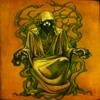This topic is started as a spin-off from another thread, to place part of my posting there in an appropriate context; it might eventually be of interest for some to continue the topic, but for now only two mirrors [unedited] of previous posts from a protected forum:
ca ca ca
Topic: Khand
Issue: Known units according to Tolkien writings.
Note on the Múmakil:
Tolkien has stated in The History of Middle-earth, that the names Khand (the land south-east of Mordor) and Variag were samples of "the speech of Men of the East and allies of Sauron". Another Khandian word is mûmak "elephant", pl. mûmakil.
The origin of the Common Speech is here formulated in these words:
There [at Pelargir] Adûnaic was spoken, to which language the tongues of Men that dwelt round about were close akin, so that already a common speech had grown up in that region and had spread thence along the coasts among all those that had dealings with Westernesse.
After typing the text my father added this sentence:A carbon copy [of the text] is extant, and here my father in a similar addition named beside múmak also Variag and Khand.
Of the speech of Men of the East and allies of Sauron all that appears is múmak, a name of the great elephant of the Harad.
Another Khandian word is mûmak "elephant", pl. mûmakil. Is the plural ending -il related to the one that possibly occurs in Forgoil, or is it an independent borrowing from Elvish?
So, the Múmakil is without any doubt a unit of Khand, or from one of the territories 'ruled' by Khand.
It should be noted, that the desert of Lothlann ("wide and empty") separated Khand from the other regions of Near Harad (Harondor, Umbar) and that Khand (unlike those) never were ruled by Gondor.
------------
Note on the Variags: The most convincing interpretation on these is the one given by Lalaith, e.g. Variags being some kind of 'elite' mercenaries.
This interpretation fits well with Tolkien's use of Old Norse as representing (some of) the early Mannish Tongues.Variags ... may in fact be a translation of a Northern Mannish root, for Variag also is a known Slavic rendering of Varingar, Old Norse for „people bound by a contract“, root vár „contract“ (from which the Varangian Guard of the Byzantinian emperors derived). Perhaps the Variags of Khand were not an ethnic group but a kind of elite mercenaries in more or less voluntary service of Mordor.
ca ca ca
Well, for now just my conclusions on Khand. There are various "threads" of lore pointing to these conclusions, about something like seven or eight, so ultimately a lot of writing. I might use this topic for some initial drafting (which means you'll see it first), then move it to the lore forum.
1. Khand is part of Harad, like Umbar - Harad is not a political entity, just a direction of the compass ("South"). As Khand and Umbar are the only realms in Harad, we'll have to reflect the history and diversity of Harad into these two realms.
2. The realm of Umbar was until late in Third Age part of Gondor, or Gondorian "sphere of interest" - Khand was never under Gondorian rule, but ruled by descendants of the Black Númenoreans, at least in those millennia where Sauron's dominion in Middle-earth was strong. Late Third Age the rulers of Umbar were of Haradric (non-Gondorian) descent.
3. Thus, at the end of Third Age, we get this intriguing complementarity:
The Rulers of Umbar were of Haradric descent, but the population mainly of Gondorian descent.
The Rulers of Khand were of Black Númenorean descent, but the population of Haradric descent.
4. Analyzing the geopolitical strategies of Sauron in the Third Age gives an interesting pattern: In the second millennium the primary aim was to destroy the Northern Kingdom (Arnor) and the Easterlings the most important (and strongest) ally. In the third millennium Sauron's primary aim was the retake and rebuild of Mordor, and in this Khand must have been of utmost importance, due to its geographical position guarding the Gap of Khand and for supply of fresh slaves - and because the Black Númenoreans were ever the most ready and trusty of all his allies.
5. In the War of the Ring it became clear, that the forces of Khand (the Haradric forces in the Battle of the Pelennor) were greater than the forces of the Easterlings, or the forces of Umbar.
6. On the Variags: these were mercenaries (cavalry), originally descendants of the Northmen, refugees from the Easterling invasions of Rhovanion.
7. The language of the ruling class of Khand must have been a dialect of Adûnaic.
Any comments? ![]()






















